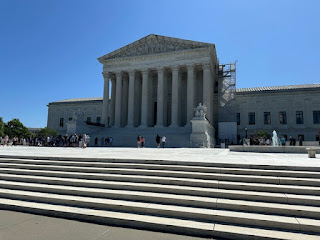If you pay any attention to the rulings coming out of the Supreme Court (and if you don't, you really should), then it won't surprise you to learn that the building is full of contradictions. In light of the increasingly partisan rulings have been handed down of late, ever less respectful of precedent and divorced from sound reasoning, the place is really feeling like a museum celebrating cognitive dissonance.
You enter on the lower floor, which is literally set up like a museum with interactive exhibits, busts and portraits of past Justices, and a viewing room devoted to one of the Court's most-celebrated rulings: Brown vs. Board of Education (desegregating schools).
One of the interactive exhibits presents short summaries of the arguments presented in a real past case, inviting you to tap your own decision. You then learn how the Court actually ruled. You might expect such an exhibit to focus on cases that vindicated individual rights, or perhaps to offer background placing rulings in historical context. Instead, the exhibit almost proudly tells you how and where the Supreme Court says it's OK for you to be surveilled, to what degree this freedom or that was cabined, and so on.
With so many Justices in the history of the Court, too many to display them all, you might expect that those who are featured in statue or portrait would be selected for specific reasons. And you might expect someone to curate what sort of message those reasons might be sending -- as they are with the wing devoted to the small handful of women to thus far serve on the Court. But it's pretty hard to understand, say, why the placard by Harry Blackmun's portrait is a few short sentences boldly declaring his foundational authorship of Roe v. Wade when the Court has pointedly (and years ago now) overruled that case. ("This guy was great. WRONG. But great." seems to be the message.)And that viewing room devoted to Brown v. Board of Education? It showcases the biggest lack of self-awareness of them all. In a room featuring artifacts related to the case, you can sit and watch a short film in which several of the current Justices give interviews about how foundational and transformative that ruling was. Several, not all. It feels notable which Justices couldn't seem to find 10 minutes to sit in front of a camera and say that they're OK with one of the country's most foundational anti-racist rulings.
But Clarence Thomas found the time. And that is rich. Literally 8 days before I was sitting in this room watching this film, Thomas authored a solo concurrence (in Alexander v. South Carolina State Conference of the NAACP) in which he argued that the government overstepped in the Brown II ruling (the case that followed up the original with a stern "we meant what we said, dummies"). Down in the Supreme Court basement, Clarence Thomas is telling gormless tourists every 10 minutes how important Brown was. Upstairs, he's writing that it was government overreach.
Basically... most of the sitting Justices on the Supreme Court really need to take a trip down to the basement. It's long been clear to me that most of them are blithely uncaring of the real-world harms brought about by their mockery of jurisprudence. And no, it's not like they're personally responsible for what's going on next to the Court gift shop (woefully shy on interesting items, by the way), nor even that they should devote much time to such things. But they've really got quite a monument to their own ignorance going on down there.
And also: here's a cool shot of the room itself where all the "magic" happens:
So, uh.... yeah... the Supreme Court is a very impressive and beautiful building with many impressive things to see. And going there was a totally dispiriting, if not enraging, experience.



No comments:
Post a Comment